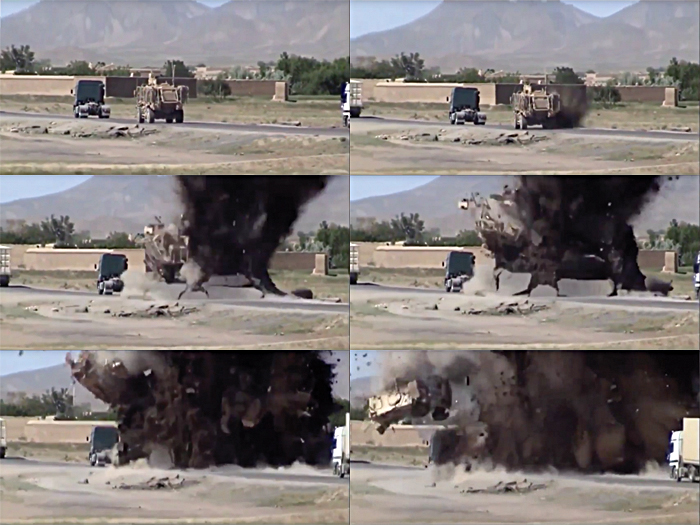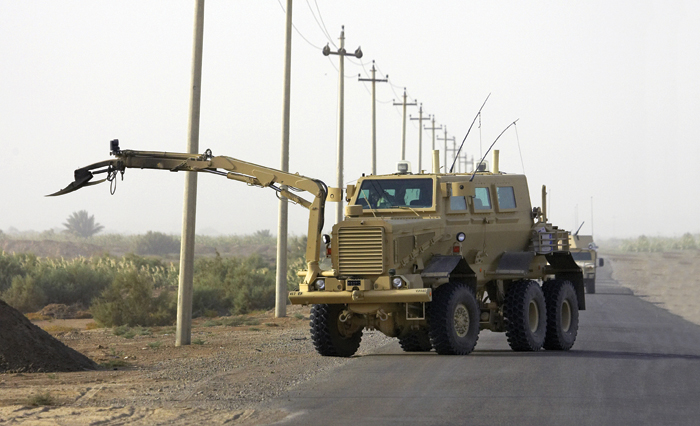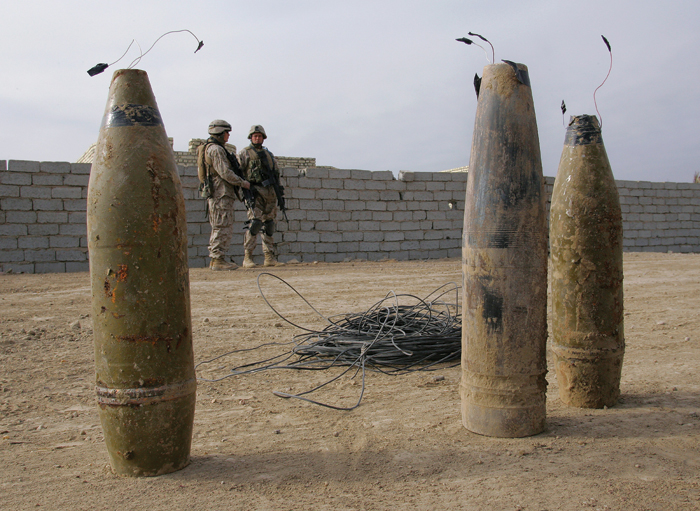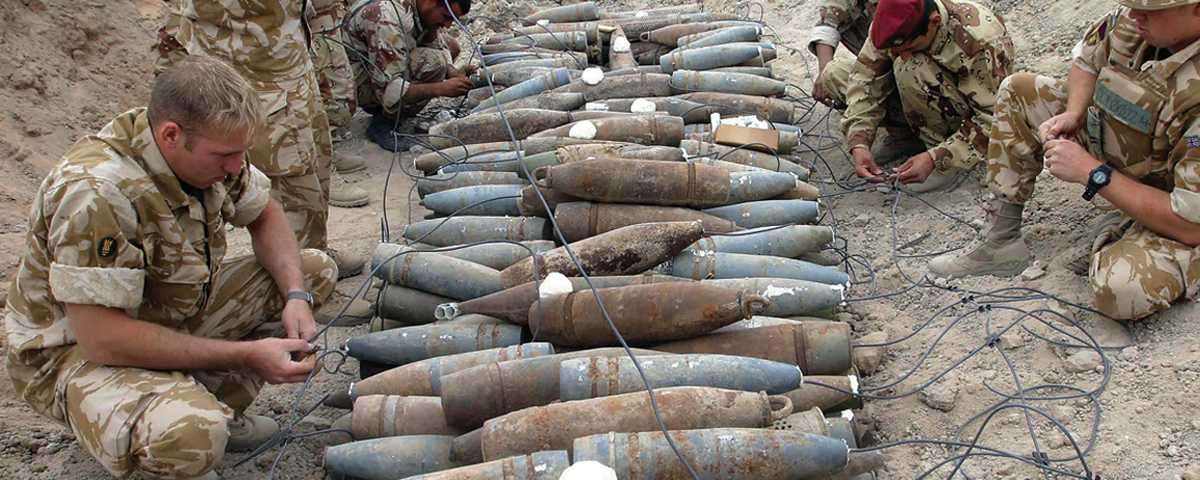IT WAS THE KIND OF ENGAGEMENT that breeds confidence. Two hours after midnight on June 24, 2004, an American resupply mission was running south on Main Supply Route Mobile, the divided six-lane highway that curves around the Iraqi city of Fallujah, when the 28-vehicle convoy ran into a massive ambush. Explosions from rocket-propelled grenades and mortar rounds bracketed the trucks as bullets ripped into them. The convoy’s security detail of 16 military police in four uparmored Humvees, led by Marine Corps 1st Lt. Nick Hurndon, met the wildest combat of their lives with cool precision. They returned fire, coordinated with air assets and pushed the convoy through the 2-mile kill zone to Camp Fallujah, a stronghold just a few miles away, while the camp’s armored quick-reaction force moved out to punish the insurgents.
Fighting continued for hours. That night Hurndon’s team took up positions on berms outside the camp, watching M1 Abrams tanks and AH-1 Cobra attack helicopters blast away at buildings along Fallujah’s east side. Crews unloaded the convoy’s trucks, and the next morning the Marines briefed a new plan, with tighter spacing between vehicles, before mounting up and rolling north through the chaotic gauntlet. Taking damage to their vehicles but no casualties, they returned fire, zipped through the danger and soon arrived back at Camp Taqaddum.
A year later, during their next deployment to Iraq, members of Hurndon’s MP unit found themselves fighting a different kind of war. Along that same stretch of MSR Mobile, Sgt. Mark Chaffin, a squad leader in Hurndon’s unit, was taking position on a hill to overwatch engineers building a new entry point into Fallujah after a major offensive had finally brought the city under coalition control. Chaffin sat beside his driver in an uparmored Humvee as his fire team climbed a dirt trail a quarter-mile off the main road.
“The next thing I remember, I was getting woke up, and we had gotten hit,” Chaffin recalled in a recent interview. “It happened, and I was out.” He came to with a mangled leg and broken nose, covered head to toe in oil and grease from the Humvee’s shattered engine. The Marines concluded they had hit a buried bomb triggered by a pressure plate—what the U.S. military calls a victim-operated improvised explosive device (VOIED). The Humvee’s armor had done its job—none of the four men inside was killed—but Chaffin’s war was over. In a millisecond one well-placed explosion had done more damage to Hurndon’s unit than hundreds of heavily armed insurgents had the year before. This time there was no enemy to engage, no air assets to call, nothing for the MPs to do but rush Chaffin to Baghdad for surgery.

Improvised explosive devices (IEDs), the signature weapons of the Iraq War, were nothing new to the world in 2004. The French Resistance had used them to derail German trains during World War II. British troops had torn out their hair trying to counter them in Northern Ireland in the 1970s, an experience the Israelis had shared in Lebanon in the ’80s. Insurgents in Afghanistan had resorted to IEDs after the U.S.-led 2001 invasion, adding radio-controlled detonators, a combination that proved especially deadly.
But IEDs proliferated with the insurgency in post–Saddam Hussein Iraq, a country overflowing with leftover ordnance and unemployed former soldiers who knew how to use it. A single artillery round contained enough explosives to destroy a tank. One buried in a roadway and triggered by a hidden observer was more accurate than any big gun. The U.S. Defense Department has come to regard the IED as one guerrilla tactic among many—like the tripwire booby trap or the sniper—a problem that truly goes away only when the insurgency itself has been snuffed out. In the interim the world’s greatest military has suffered thousands of casualties and spent billions of dollars searching for a technological solution that remains elusive.
The vast majority of soldiers and Marines entering Iraq in spring 2003 knew nothing about detecting and countering IEDs. They had been trained to invade and hold territory against a foreign army. In a trade for speed over armor they fielded relatively few mechanized vehicles, such as tanks and armored troop carriers, and lots of thin-skinned Humvees, many without doors. When Army Pfc. Jeremiah Smith was killed by a bomb triggered beneath his vehicle a few weeks after the invasion ended, the Pentagon was so unfamiliar with the threat it failed to recognize the device as an IED, instead declaring Smith’s vehicle had hit “unexploded ordnance.”
The vast majority of soldiers and Marines entering Iraq in spring 2003 knew nothing about detecting and countering IEDs. They had been trained to invade and hold territory against a foreign army
By that summer, with an uptick in the enemy use of IEDs, it became clear troops needed more protection. The Pentagon hired vendors to produce 25,000 sets of body armor per month and scoured bases across the United States for uparmored Humvees. Only 235 such vehicles made it to Iraq in 2003, so troops got creative. They covered vehicle floors with sandbags, put Kevlar blast blankets beneath their seats, strapped ceramic armor plates to their doors and bolted on scrap metal “hillbilly armor” wherever it would fit.
The number of IEDs attacks increased month after month, as did the ingenuity of the insurgent cells mounting them. A typical cell was led by a planner/financier who employed the bomb maker, emplacer, triggerman, a spotter or two and a cameraman, who videoed attacks for propaganda use and to help plan future attacks. The insurgents buried the explosive-packed artillery rounds beside roads, set them in parked cars or perhaps hid them in animal carcasses, then detonated the devices at just the right moment using a mobile phone, garage door opener, even the receiver unit of a remote-controlled toy car.
A lethal cat-and-mouse game developed. When convoys avoided certain trouble spots, insurgents emplaced IEDs on the alternate routes. When a new standard operating procedure instructed drivers to halt 300 meters from a suspected IED, insurgents took to placing a readily visible bomb 300 meters from a well-hidden one, then triggering the concealed device when convoys stopped to wait for explosive ordnance disposal (EOD) teams.
The emerging heroes of the war, EOD technicians from the Army, Navy, Air Force and Marines endured the same rigorous training and performed the same risky duty. Like firefighters, EOD teams relied on field personnel to discover IEDs and call for help. The disposal team would drive to the site, neutralize the bomb, do a quick forensic analysis and get out quickly. Staying more than a few minutes invited an insurgent mortar attack. The teams shuttled all over Iraq, with infantry or military police as security, and used a variety of gadgets to disarm or destroy insurgent bombs. One favored method employed concentrated water jets to tear apart IEDs without detonating them. As the war progressed, EOD techs increasingly relied on robots—from the compact PackBot to the 485-pound ANDROS F6-A—to do the work at a distance, but by fall 2003 only 18 such robots were in theater, and just six of those were functioning.
With little direction from above, convoy troops tried everything they could think of to counter roadside bombs. Some installed leaf blowers on vehicle bumpers to clear the trash-strewn Iraqi streets and uncover IEDs. Hoping to cut down on false positives, some used bomb-sniffing dogs, but the animals quickly lost their enthusiasm in the 120-plus-degree heat. Hoping to speed up the demolition process, others fired on suspected bombs using .50-caliber rounds, shotguns and Vietnam-era 40 mm grenade launchers someone had pulled from storage and sent to the theater. But if an explosion occurred, did that mean the threat was neutralized? An IED could comprise a string of more than 20 artillery rounds.
Whether to use vehicle lights during night operations depended on the mission and the proclivities of convoy commanders. EOD technicians and their security teams usually ran blacked out wearing night-vision goggles (NVGs), but blacked-out supply vehicles kept running into things. Drivers of the 7-ton trucks hated wearing the cumbersome goggles, which cut off peripheral vision and were susceptible to glare.
Early in the war, still regarding IEDs as one element of a small-arms ambush, convoy security troops ran in blacked-out Humvees to preserve the element of surprise in the event a counterattack was required. But as small-arms ambushes waned, and IEDs became the main threat, even MPs learned to love big lights. They attached spotlights and rally lights to their Humvees and changed tactics accordingly. The lead security vehicle would push far ahead of the convoy, then slow down to search suspicious areas. The later use of infrared headlights in tandem with NVGs proved effective, and some security detachments went back to running dark.

By summer 2004 a particularly nasty type of IED started appearing in Iraq—the explosively formed projectile (EFP). To create one, a bomb maker capped an explosives-filled cylinder with a dish-shaped copper or steel liner, concave side out. An emplacer then concealed the device along a supply route, perhaps within Styrofoam cut and painted to look like a rock or part of a roadside wall. Many such devices were fitted with passive infrared sensors that could detect the heat signature of a passing vehicle. When the device detonated, the force of the blast warped the disk into a superheated slug traveling some six times the speed of sound. Capable of penetrating virtually any armored vehicle, the EFP sprayed its occupants with molten metal. Ever adaptable troops started dangling radiators, toasters and the like on poles jury-rigged to the front bumpers of their vehicles to pre-detonate EFPs. Riffing on that concept, military engineers developed a countermeasure called the Rhino—an electronic heating element, or glow plug, housed in a steel box at the end of a fixed boom attached to a vehicle’s front bumper. When insurgents angled back EFPs to counter that decoy, engineers fitted the Rhino with an adjustable-length boom.
No matter what countermeasures troops employed, however, the IED threat persisted. Coalition forces reported just 22 IED incidents in June 2003, a toll that climbed to 1,582 by year’s end. Total incidents climbed to 8,446 in 2004 and 15,322 in 2005. The annual toll peaked in 2006 at 24,099 incidents, of which effective attacks killed 558 troops, or 64 percent of those killed in action in theater that year.
It became increasingly clear the coalition’s most efficient method for detecting IEDs was a well-trained, alert soldier who repeatedly traveled the same supply route and noticed changes in the environment. Troops sarcastically referred to this technology as the ‘Mark 1 Human Eyeball’
Meanwhile, a new Pentagon task force had been throwing resources at the problem. In fall 2003 Lt. Gen. Richard Cody, then Army deputy chief of staff for operations, told his staff to hire a small group of former special-operations soldiers and work the issue from a basement office in the Pentagon. Brig. Gen. Joseph Votel led the group, estimating the struggle to control IEDs would take between six and eight months. The first field team of seven contractors arrived in Iraq in mid-December 2003 to work with the Army’s 4th Infantry Division. They taught basic convoy tactics—change routes frequently, have guns always at the ready, watch for wires and triggermen, etc. Votel’s task force soon expanded into a joint-services group working with some 132 government agencies. Its $100 million budget in fiscal year 2004 ballooned to $1.3 billion in 2005. In a nod to the intensive World War II effort to develop atomic weapons, Gen. John Abizaid, commander of U.S. Central Command, called for a “Manhattan Project–like” approach to defeat the IED threat. He also asked the Defense Department to develop a molecular-level bomb sniffer that could be mounted on convoy vehicles.
Willing to explore any potentially useful anti-IED system—even flying insects—the Pentagon shelled out more than $2 million for the Stealthy Insect Sensor Project at Los Alamos National Laboratory. Harnessing bees’ acute sense of smell, scientists found they could condition the insects to stick out their proboscises for a sweet reward whenever they sniffed explosives like TNT or C-4. Harnessed in a tube and observed via camera, a bee would signal the presence of such explosives. Training 50 bees took just two to three hours, but the harnessed bees lived mere days. When informed of the results, Votel had serious doubts. “How do we operationalize this?” he asked. “How does, say, 1st Platoon manage their bees?” The project was quietly dropped.
In late summer 2004 the Pentagon started funding an experiment dubbed IED Blitz. Martialing a range of air reconnaissance assets—U-2 and C-12R manned aircraft, drones and satellites—coalition forces scrutinized one especially hazardous stretch of MSR Tampa north of Baghdad. The various platforms took some 10,000 images per day, which analysts compared for anomalies in a process called “coherent change detection.” The photos were so clear, interpreters could read the labels on water bottles. What they couldn’t do was find bombs. During the $3 million, 10-week experiment 44 IEDs exploded or were cleared by EOD teams along that stretch of MSR Tampa. IED Blitz caught none of them.
Throughout this trial-and-error period the Defense Department pursued what it called counter radio-controlled IED electronic warfare (CREW), sending thousands of vehicle-mounted electronic jammers to Iraq to thwart radio-controlled IEDs. All jammers in theater were to be programmed according to the MOASS (mother of all spreadsheets), a list of enemy-employed radio frequencies collected, analyzed and distributed on the military’s secure internet. Yet field troops were poorly trained on how to program and update their jammers, and the devices often interfered with convoy radios. Many convoy commanders shut them off as soon as they got outside the wire. Some suspected the jammers didn’t work at all.
The search for a solution continued. Several research teams tried employing lasers, microwaves and other high-energy devices to disarm or explode IEDs from a safe distance. One exciting invention, an unmanned vehicle dubbed the Joint IED Neutralizer (JIN), used tesla coils generating a half-million volts to detonate blasting caps, but it proved effective from a distance only when the caps were above ground. When dealing with a buried IED, the JIN had to close within 3 feet to trigger a blast, which in turn destroyed the vehicle itself, at a cost of $800,000 per pop.
It became increasingly clear the coalition’s most efficient method for detecting IEDs was a well-trained, alert soldier who repeatedly traveled the same supply route and noticed changes in the environment. Troops sarcastically referred to this technology as the “Mark 1 Human Eyeball.”

As IED casualties mounted, a new argument emerged about the definition of combat itself. Service members headed home wearing Purple Hearts for wounds suffered in IED attacks, but they weren’t authorized to wear their service’s Combat Action Ribbon or Badge. According to military directives, since these incidents didn’t involve direct personal contact with an enemy, they weren’t considered combat. Officers on the ground started a quiet campaign to change the rules. A June 2005 memo by Marines in Anbar Province argued, “To state that the Marines who encounter this new form of enemy action have not experienced ‘combat action’ is to interpret the award based on an old definition of combat and would deny the Marines who have performed their duties honorably in the face of this new faceless enemy the distinction of being formally recognized with the Combat Action Ribbon.” Within a year the Marines authorized IED victims to wear the CAR, retroactive to fall 2001, and in 2008 the Army did the same for the CAB.
That debate paralleled a major shift in roles for servicewomen. The injury, capture and rescue of Army Pfc. Jessica Lynch during the invasion epitomized a problem that expanded with the insurgency. Though officially women were barred from serving in combat, they were being asked to go outside the wire, not only to drive convoys, but also to search and interrogate Iraqi women and fill other roles necessary in a gender-segregated Muslim society. Since any trip off base invited contact with the enemy, by the military’s new definition women were regularly engaging in combat. Bringing the law in line with the reality on the ground, Secretary of Defense Leon Panetta eventually lifted the ban on women in combat 10 years after the Iraq invasion.
In late 2005 Pentagon leaders finally admitted they could find no magic bullet to defeat IEDs. No amount of jamming or armor would stop them completely, and killing insurgents who emplaced or detonated the bombs wasn’t putting a dent in the threat. Instead coalition forces would take the fight “left of boom”—that is, before an explosion—by interrupting supply chains and arresting the bombs’ clandestine manufacturers. As part of a broader counterinsurgency program, the Pentagon expanded its anti-IED task force, creating the Joint IED Defeat Organization with a mandate to confront “the entire IED system.” JIEDDO marked an important shift from reactive stopgaps to strategic planning. Retired Gen. Montgomery Meigs took the helm and declared it his goal to “defeat IEDs as weapons of strategic influence,” not to defeat every IED. The difference in approach was huge. Focusing on IEDs as a tool of influence, Meigs sought to loosen insurgents’ strategic hold on the Iraqi population. With a nearly $4 billion budget for 2006, Meigs funded three lines of operation: defeat the device through armor, jamming and other countermeasures; attack the network that funded and built IEDs; and train troops on the ground in a range of anti-IED techniques. Since renamed the Joint Improvised-Threat Defeat Organization, the group continues to pursue the same three-pronged mission. IEDs are here to stay. MH
Paul X. Rutz is an artist, freelance writer and former Navy officer. For further reading he recommends The Long Walk: A Story of War and the Life That Follows, by Brian Castner, and “Left of Boom: The Struggle to Defeat Roadside Bombs,” a 2007 four-part series in the The Washington Post, by Rick Atkinson.





